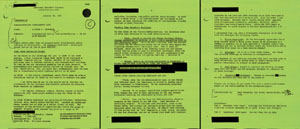9.30.24 — Voided
To wrap up from last time, Jenny Holzer started with something less public and more obscure. Diagrams taken from science and engineering bear not quite appropriate titles.
And then comes something surprising from so talkative an artist, emptiness. The show really does have empty bays. It becomes a collaboration with Frank Lloyd Wright and his museum, just as with Quiñones and countless others, but not without her usual defiance. When she first installed her crawl screen rising up, exhibitions started at the top and worked their way down. 
Silence allows voices to linger in memory, and it asks, too, just who gets to speak. Sure enough, when the artist first moved past crawl screens and truisms, it was to censorship. Paintings in oil of official documents have more than just the names blacked out. They run to near uniform blackness. One document duly states that it never mentions George Orwell, but that is after censorship. His file, now “voided,” once voided him.
Holzer’s first New York retrospective had a heavy bias toward recent work, at the time the marks of the censor. So does this one. Blame it if you like on the curator, Lauren Hinkson, but this artist hears living voices, and she wants her work to live in the present as well. She projects more messages on the museum’s façade at sunset early in the show’s run. When she at last returns to lies and clichés, it is to the unchallenged master of both. Trump and his party gild the lies, and so does she in silver and gold leaf.
Trump’s words appear on fragmented metal, ending in a loose pile on the floor, and her own marble lies up the ramp in fragments as well. Now if only he could be so easily consigned to the ash heap of history. One outburst portrays the January 7 uprising as an epic event, and more paintings capture the voices around him the day itself. Trump-appointed judges are determined to see that courtroom testimony comes only after the election, if it takes place at all. Smeared paint may not show Holzer at her best, but it will have to do. When the crawl screen pauses its messaging briefly to flash in red, it could be sounding the alarm.
Text like hers would look good on t-shirts, and one can see their influence on Rirkrit Tiravanija and his freebies reading The Odious Smell of Truth. Never mind his political neutrality and pandering. They parallel, too, John Baldessari and his California irony, but without his glib detachment. They have an echo as well in the terse anger of Glenn Ligon—or the sheer excess of another African American, Adam Pendleton. I leave Holzer’s influence on text art and her 2009 Whitney retrospective to earlier reviews. She has returned earlier to the Guggenheim, too, as curator of its collection, and you can check out the links for a far fuller picture.
The show’s biases raise tough questions. What is the point of a retrospective anyway? How do the certainties and complexities of Postmodernism look today? Holzer’s whole body of work explores biases, and even her squares of gold look like the marks of a censor. Still, the opening overflow of light, text, and color lingers longest and matters most. For once, the museum rotunda talks back.
Read more, now in a feature-length article on this site.